Nokia: Analysis and Strategies for Re-emergence
VerifiedAdded on 2023/01/16
|14
|2774
|67
AI Summary
This article provides an analysis of Nokia's current position and strategies for re-emergence in the market. It covers Porter's 5 forces, stakeholders analysis, PESTEL analysis, SWOT analysis, technology cycle, the Utterback and Abernathy Model, and the McKinsey 7-S Model. It also discusses how Nokia can re-emerge in the new market and the capabilities and resources needed for its success.
Contribute Materials
Your contribution can guide someone’s learning journey. Share your
documents today.
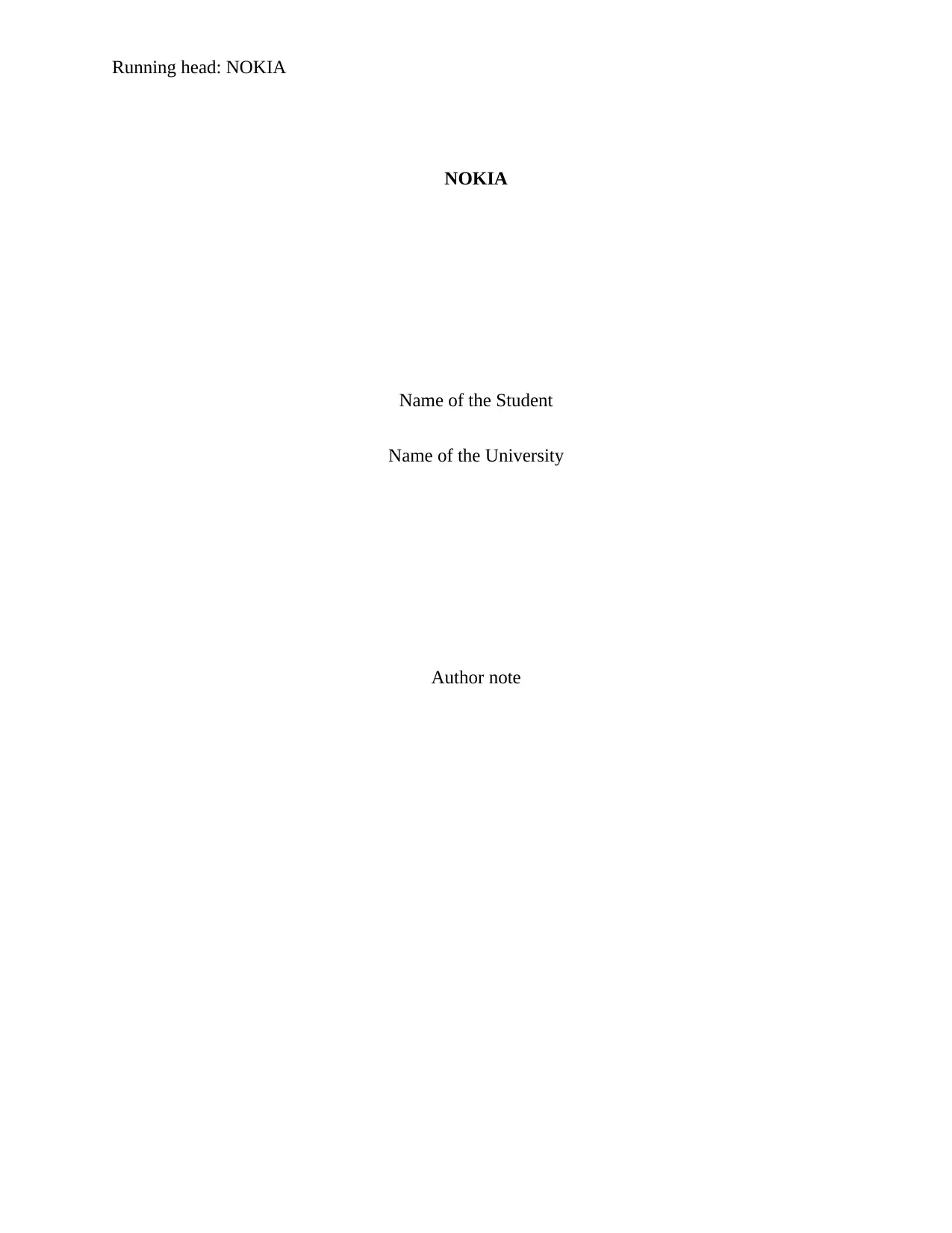
Running head: NOKIA
NOKIA
Name of the Student
Name of the University
Author note
NOKIA
Name of the Student
Name of the University
Author note
Secure Best Marks with AI Grader
Need help grading? Try our AI Grader for instant feedback on your assignments.

1
NOKIA
Table of Contents
NOKIA................................................................................................................................2
Porter’s 5 forces...................................................................................................................2
Stakeholders analysis:..........................................................................................................3
PESTEL...............................................................................................................................4
SWOT..................................................................................................................................5
Technology cycle:................................................................................................................6
The Utterback and Abernathy Model:.................................................................................6
McKinsey 7-S Model...........................................................................................................7
Hard elements..............................................................................................................7
Soft elements...............................................................................................................8
How Nokia can re-emerge in the new market:....................................................................8
Determining and explaining the capabilities and resources needed by Nokia:...................9
References..........................................................................................................................11
NOKIA
Table of Contents
NOKIA................................................................................................................................2
Porter’s 5 forces...................................................................................................................2
Stakeholders analysis:..........................................................................................................3
PESTEL...............................................................................................................................4
SWOT..................................................................................................................................5
Technology cycle:................................................................................................................6
The Utterback and Abernathy Model:.................................................................................6
McKinsey 7-S Model...........................................................................................................7
Hard elements..............................................................................................................7
Soft elements...............................................................................................................8
How Nokia can re-emerge in the new market:....................................................................8
Determining and explaining the capabilities and resources needed by Nokia:...................9
References..........................................................................................................................11

2
NOKIA
NOKIA
Porter’s 5 forces
Threat of new entrances
Nokia: Chances of new entrances in their market is not very high. The platform on which
Nokia functions is easy to use. Android platform is used by most of the mobile manufacturing
organizations. The base of android is also cheap and almost for free. Nokia is incumbent as
compared to Apple (Vuori and Huy 2016).
Threats of substitute
Nokia: Threat of substitute of the brand is not high. The main reason is that most of the
mobile manufacturing brands use the platform of Android and hence with provisioning of better
specifications can be provided, making it incumbent.
Bargaining power of buyers
Nokia: Bargaining power of the employees are comparatively higher than that of the
IPhone. The major reason behind this issue is that the entire setup that is provided by Nokia in
today’s generation provides better specification and this makes IPhone the challenger and Nokia
the incumbent (Majanoja, Linko and Leppänen 2017).
Bargaining power of suppliers
Nokia: Bargaining power of suppliers are very high as the competition against the brand
is not very high. The products that are present includes better understanding of the demands of
the clients and a blend of hardware and high end specification makes it incumbent.
NOKIA
NOKIA
Porter’s 5 forces
Threat of new entrances
Nokia: Chances of new entrances in their market is not very high. The platform on which
Nokia functions is easy to use. Android platform is used by most of the mobile manufacturing
organizations. The base of android is also cheap and almost for free. Nokia is incumbent as
compared to Apple (Vuori and Huy 2016).
Threats of substitute
Nokia: Threat of substitute of the brand is not high. The main reason is that most of the
mobile manufacturing brands use the platform of Android and hence with provisioning of better
specifications can be provided, making it incumbent.
Bargaining power of buyers
Nokia: Bargaining power of the employees are comparatively higher than that of the
IPhone. The major reason behind this issue is that the entire setup that is provided by Nokia in
today’s generation provides better specification and this makes IPhone the challenger and Nokia
the incumbent (Majanoja, Linko and Leppänen 2017).
Bargaining power of suppliers
Nokia: Bargaining power of suppliers are very high as the competition against the brand
is not very high. The products that are present includes better understanding of the demands of
the clients and a blend of hardware and high end specification makes it incumbent.
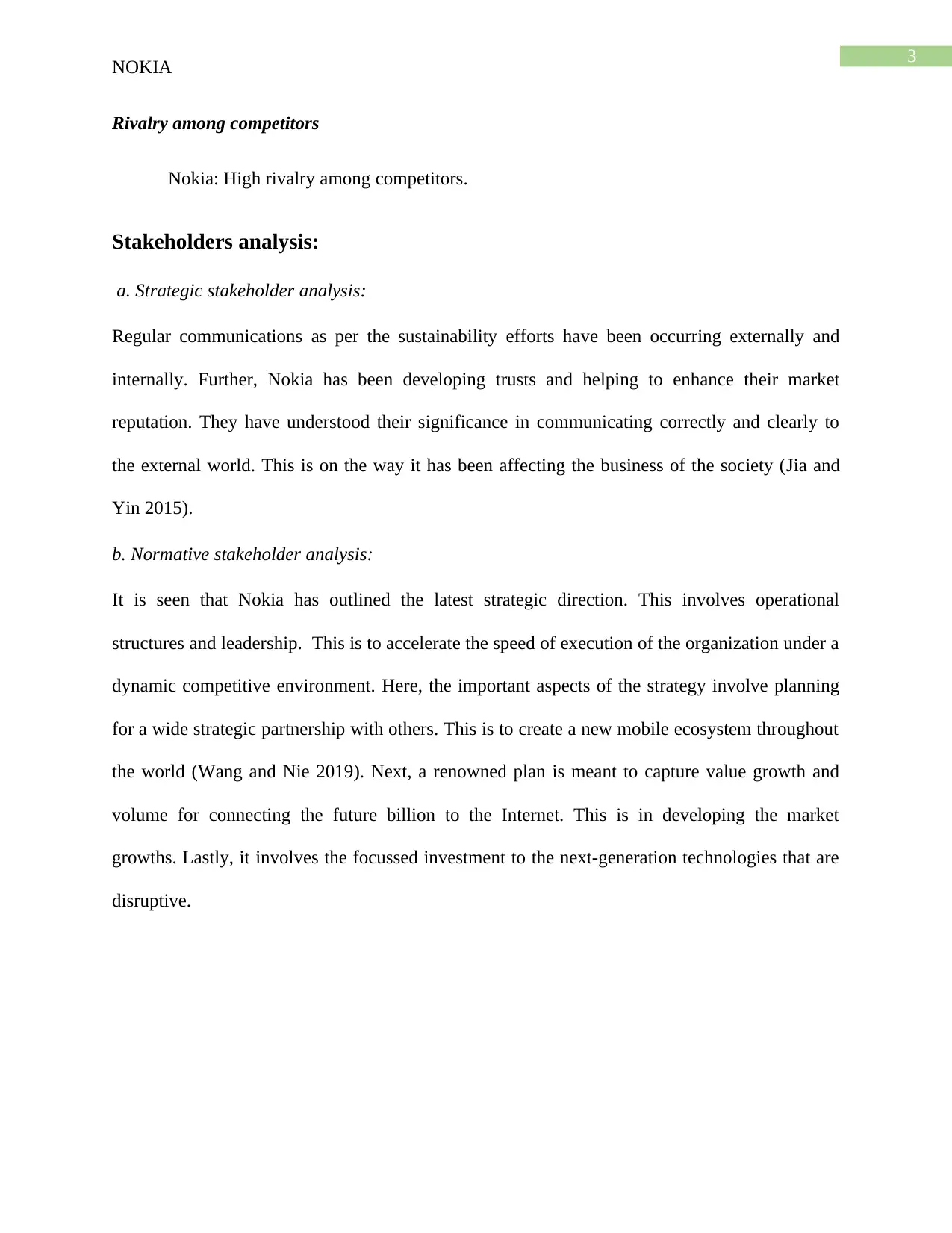
3
NOKIA
Rivalry among competitors
Nokia: High rivalry among competitors.
Stakeholders analysis:
a. Strategic stakeholder analysis:
Regular communications as per the sustainability efforts have been occurring externally and
internally. Further, Nokia has been developing trusts and helping to enhance their market
reputation. They have understood their significance in communicating correctly and clearly to
the external world. This is on the way it has been affecting the business of the society (Jia and
Yin 2015).
b. Normative stakeholder analysis:
It is seen that Nokia has outlined the latest strategic direction. This involves operational
structures and leadership. This is to accelerate the speed of execution of the organization under a
dynamic competitive environment. Here, the important aspects of the strategy involve planning
for a wide strategic partnership with others. This is to create a new mobile ecosystem throughout
the world (Wang and Nie 2019). Next, a renowned plan is meant to capture value growth and
volume for connecting the future billion to the Internet. This is in developing the market
growths. Lastly, it involves the focussed investment to the next-generation technologies that are
disruptive.
NOKIA
Rivalry among competitors
Nokia: High rivalry among competitors.
Stakeholders analysis:
a. Strategic stakeholder analysis:
Regular communications as per the sustainability efforts have been occurring externally and
internally. Further, Nokia has been developing trusts and helping to enhance their market
reputation. They have understood their significance in communicating correctly and clearly to
the external world. This is on the way it has been affecting the business of the society (Jia and
Yin 2015).
b. Normative stakeholder analysis:
It is seen that Nokia has outlined the latest strategic direction. This involves operational
structures and leadership. This is to accelerate the speed of execution of the organization under a
dynamic competitive environment. Here, the important aspects of the strategy involve planning
for a wide strategic partnership with others. This is to create a new mobile ecosystem throughout
the world (Wang and Nie 2019). Next, a renowned plan is meant to capture value growth and
volume for connecting the future billion to the Internet. This is in developing the market
growths. Lastly, it involves the focussed investment to the next-generation technologies that are
disruptive.
Secure Best Marks with AI Grader
Need help grading? Try our AI Grader for instant feedback on your assignments.
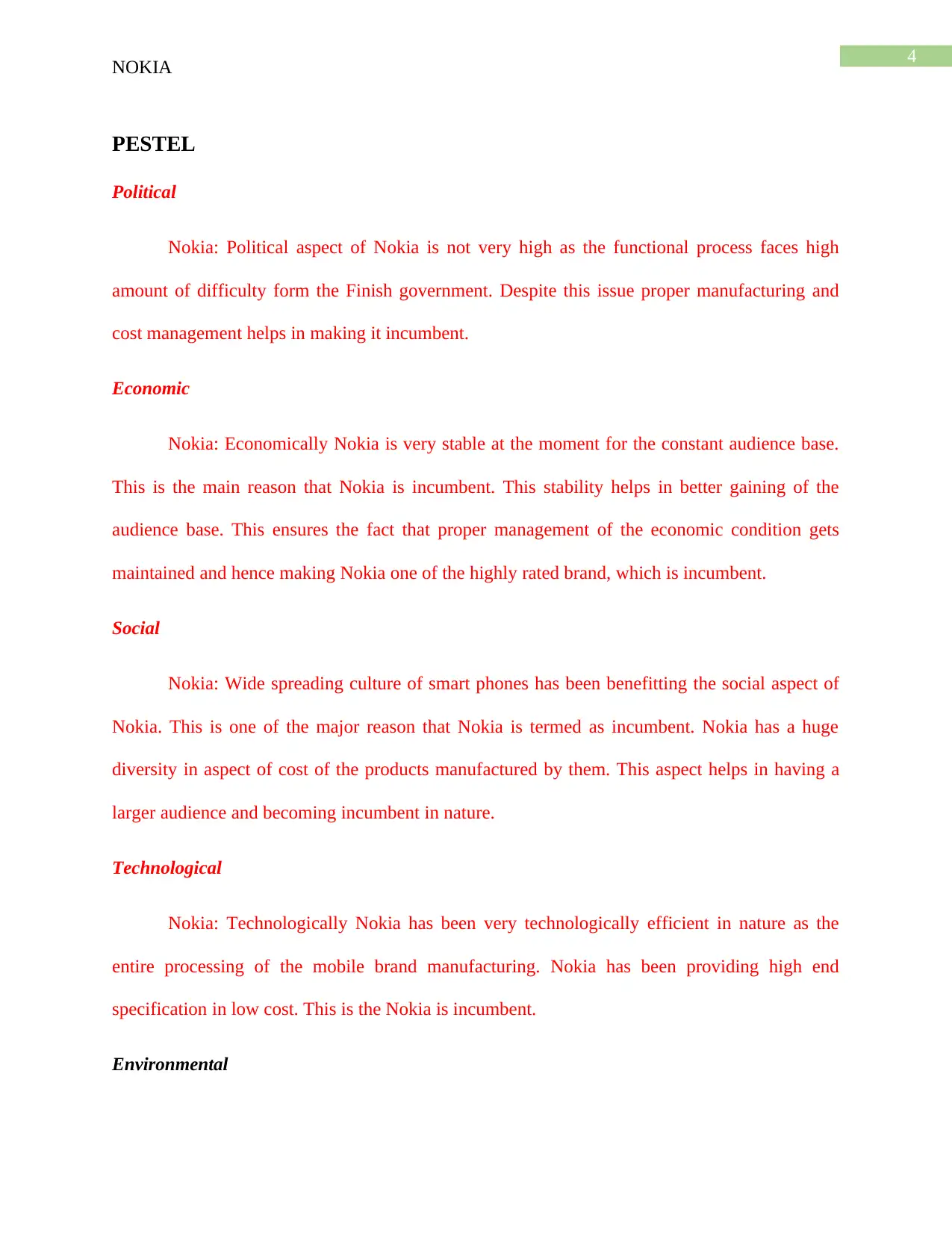
4
NOKIA
PESTEL
Political
Nokia: Political aspect of Nokia is not very high as the functional process faces high
amount of difficulty form the Finish government. Despite this issue proper manufacturing and
cost management helps in making it incumbent.
Economic
Nokia: Economically Nokia is very stable at the moment for the constant audience base.
This is the main reason that Nokia is incumbent. This stability helps in better gaining of the
audience base. This ensures the fact that proper management of the economic condition gets
maintained and hence making Nokia one of the highly rated brand, which is incumbent.
Social
Nokia: Wide spreading culture of smart phones has been benefitting the social aspect of
Nokia. This is one of the major reason that Nokia is termed as incumbent. Nokia has a huge
diversity in aspect of cost of the products manufactured by them. This aspect helps in having a
larger audience and becoming incumbent in nature.
Technological
Nokia: Technologically Nokia has been very technologically efficient in nature as the
entire processing of the mobile brand manufacturing. Nokia has been providing high end
specification in low cost. This is the Nokia is incumbent.
Environmental
NOKIA
PESTEL
Political
Nokia: Political aspect of Nokia is not very high as the functional process faces high
amount of difficulty form the Finish government. Despite this issue proper manufacturing and
cost management helps in making it incumbent.
Economic
Nokia: Economically Nokia is very stable at the moment for the constant audience base.
This is the main reason that Nokia is incumbent. This stability helps in better gaining of the
audience base. This ensures the fact that proper management of the economic condition gets
maintained and hence making Nokia one of the highly rated brand, which is incumbent.
Social
Nokia: Wide spreading culture of smart phones has been benefitting the social aspect of
Nokia. This is one of the major reason that Nokia is termed as incumbent. Nokia has a huge
diversity in aspect of cost of the products manufactured by them. This aspect helps in having a
larger audience and becoming incumbent in nature.
Technological
Nokia: Technologically Nokia has been very technologically efficient in nature as the
entire processing of the mobile brand manufacturing. Nokia has been providing high end
specification in low cost. This is the Nokia is incumbent.
Environmental
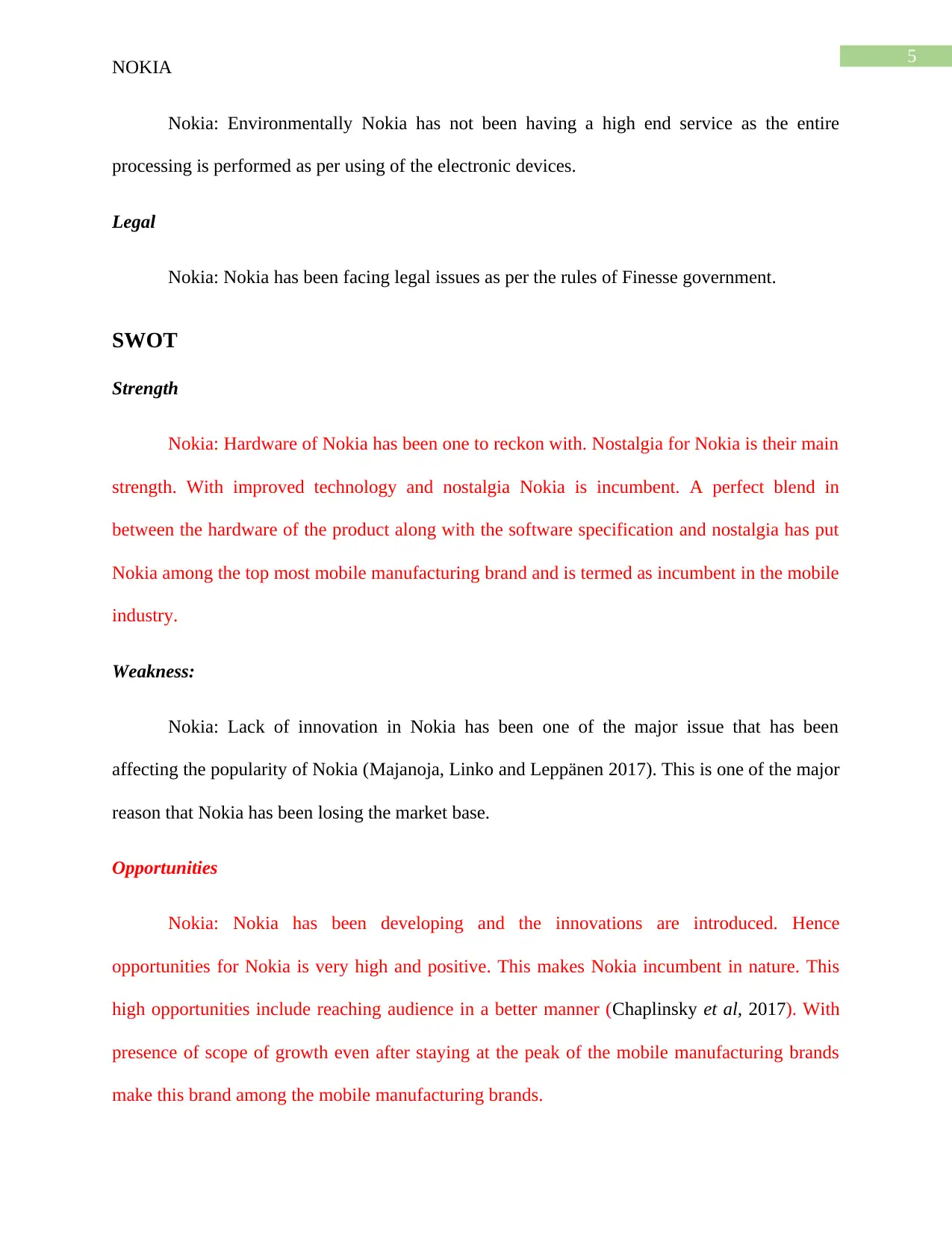
5
NOKIA
Nokia: Environmentally Nokia has not been having a high end service as the entire
processing is performed as per using of the electronic devices.
Legal
Nokia: Nokia has been facing legal issues as per the rules of Finesse government.
SWOT
Strength
Nokia: Hardware of Nokia has been one to reckon with. Nostalgia for Nokia is their main
strength. With improved technology and nostalgia Nokia is incumbent. A perfect blend in
between the hardware of the product along with the software specification and nostalgia has put
Nokia among the top most mobile manufacturing brand and is termed as incumbent in the mobile
industry.
Weakness:
Nokia: Lack of innovation in Nokia has been one of the major issue that has been
affecting the popularity of Nokia (Majanoja, Linko and Leppänen 2017). This is one of the major
reason that Nokia has been losing the market base.
Opportunities
Nokia: Nokia has been developing and the innovations are introduced. Hence
opportunities for Nokia is very high and positive. This makes Nokia incumbent in nature. This
high opportunities include reaching audience in a better manner (Chaplinsky et al, 2017). With
presence of scope of growth even after staying at the peak of the mobile manufacturing brands
make this brand among the mobile manufacturing brands.
NOKIA
Nokia: Environmentally Nokia has not been having a high end service as the entire
processing is performed as per using of the electronic devices.
Legal
Nokia: Nokia has been facing legal issues as per the rules of Finesse government.
SWOT
Strength
Nokia: Hardware of Nokia has been one to reckon with. Nostalgia for Nokia is their main
strength. With improved technology and nostalgia Nokia is incumbent. A perfect blend in
between the hardware of the product along with the software specification and nostalgia has put
Nokia among the top most mobile manufacturing brand and is termed as incumbent in the mobile
industry.
Weakness:
Nokia: Lack of innovation in Nokia has been one of the major issue that has been
affecting the popularity of Nokia (Majanoja, Linko and Leppänen 2017). This is one of the major
reason that Nokia has been losing the market base.
Opportunities
Nokia: Nokia has been developing and the innovations are introduced. Hence
opportunities for Nokia is very high and positive. This makes Nokia incumbent in nature. This
high opportunities include reaching audience in a better manner (Chaplinsky et al, 2017). With
presence of scope of growth even after staying at the peak of the mobile manufacturing brands
make this brand among the mobile manufacturing brands.
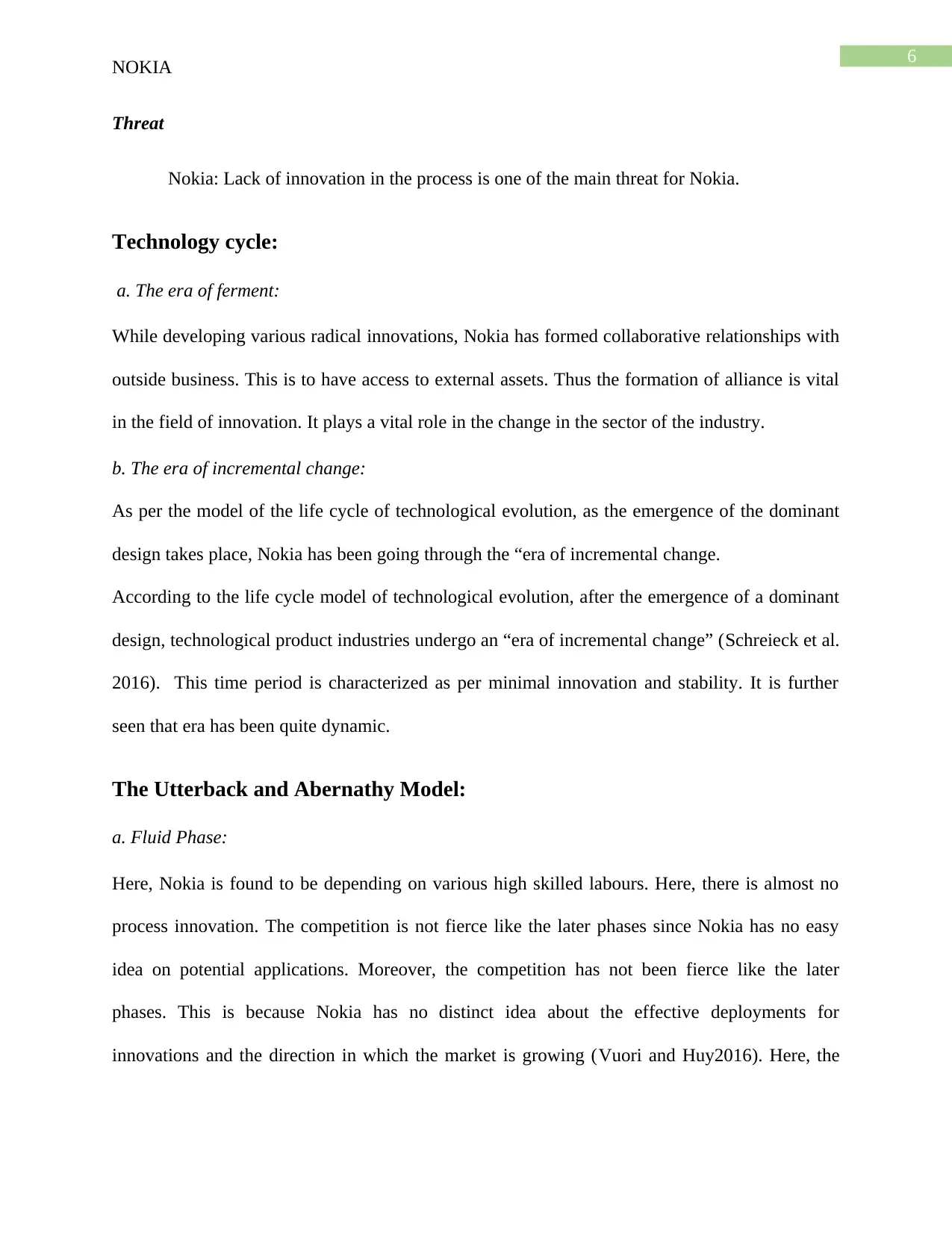
6
NOKIA
Threat
Nokia: Lack of innovation in the process is one of the main threat for Nokia.
Technology cycle:
a. The era of ferment:
While developing various radical innovations, Nokia has formed collaborative relationships with
outside business. This is to have access to external assets. Thus the formation of alliance is vital
in the field of innovation. It plays a vital role in the change in the sector of the industry.
b. The era of incremental change:
As per the model of the life cycle of technological evolution, as the emergence of the dominant
design takes place, Nokia has been going through the “era of incremental change.
According to the life cycle model of technological evolution, after the emergence of a dominant
design, technological product industries undergo an “era of incremental change” (Schreieck et al.
2016). This time period is characterized as per minimal innovation and stability. It is further
seen that era has been quite dynamic.
The Utterback and Abernathy Model:
a. Fluid Phase:
Here, Nokia is found to be depending on various high skilled labours. Here, there is almost no
process innovation. The competition is not fierce like the later phases since Nokia has no easy
idea on potential applications. Moreover, the competition has not been fierce like the later
phases. This is because Nokia has no distinct idea about the effective deployments for
innovations and the direction in which the market is growing (Vuori and Huy2016). Here, the
NOKIA
Threat
Nokia: Lack of innovation in the process is one of the main threat for Nokia.
Technology cycle:
a. The era of ferment:
While developing various radical innovations, Nokia has formed collaborative relationships with
outside business. This is to have access to external assets. Thus the formation of alliance is vital
in the field of innovation. It plays a vital role in the change in the sector of the industry.
b. The era of incremental change:
As per the model of the life cycle of technological evolution, as the emergence of the dominant
design takes place, Nokia has been going through the “era of incremental change.
According to the life cycle model of technological evolution, after the emergence of a dominant
design, technological product industries undergo an “era of incremental change” (Schreieck et al.
2016). This time period is characterized as per minimal innovation and stability. It is further
seen that era has been quite dynamic.
The Utterback and Abernathy Model:
a. Fluid Phase:
Here, Nokia is found to be depending on various high skilled labours. Here, there is almost no
process innovation. The competition is not fierce like the later phases since Nokia has no easy
idea on potential applications. Moreover, the competition has not been fierce like the later
phases. This is because Nokia has no distinct idea about the effective deployments for
innovations and the direction in which the market is growing (Vuori and Huy2016). Here, the
Paraphrase This Document
Need a fresh take? Get an instant paraphrase of this document with our AI Paraphraser
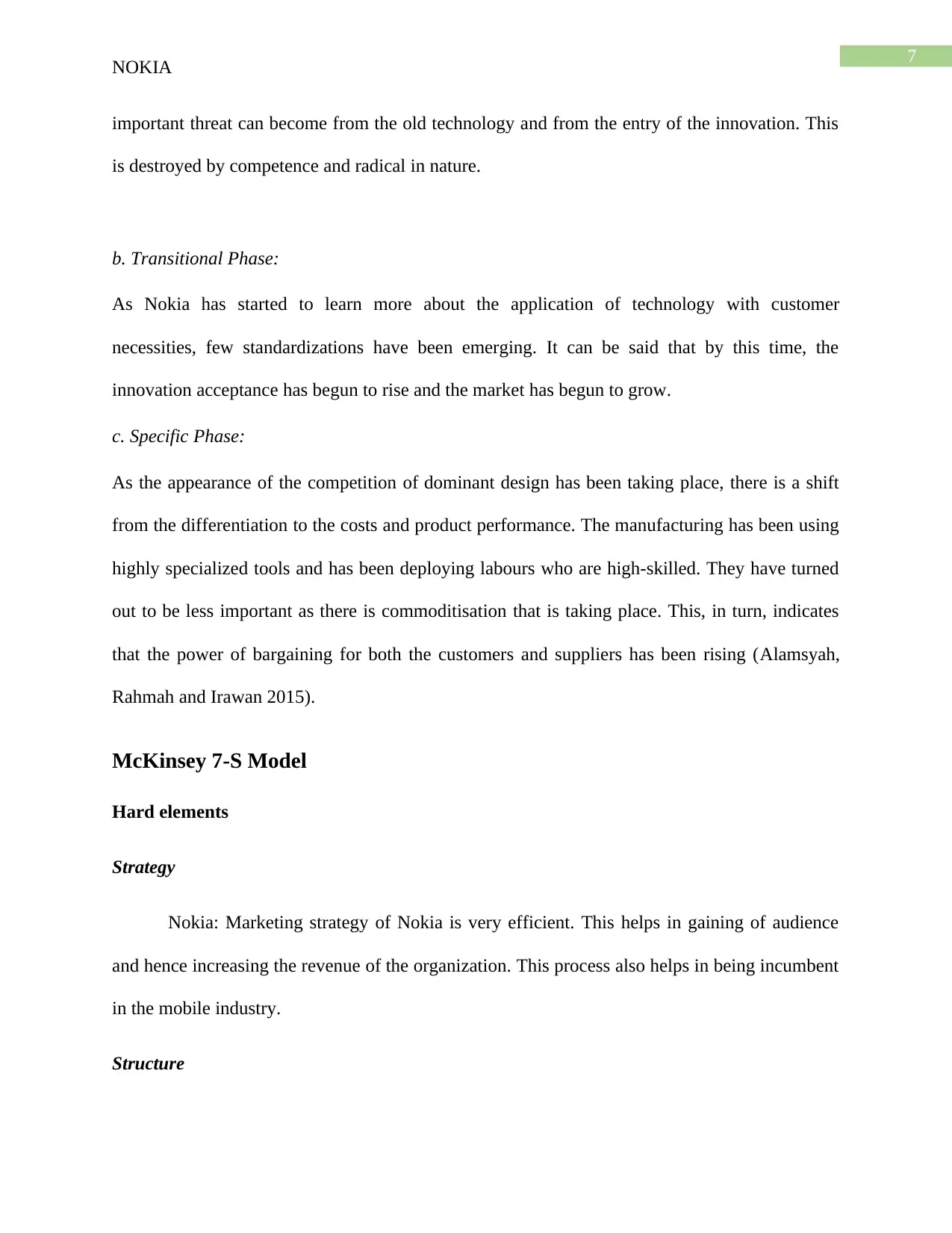
7
NOKIA
important threat can become from the old technology and from the entry of the innovation. This
is destroyed by competence and radical in nature.
b. Transitional Phase:
As Nokia has started to learn more about the application of technology with customer
necessities, few standardizations have been emerging. It can be said that by this time, the
innovation acceptance has begun to rise and the market has begun to grow.
c. Specific Phase:
As the appearance of the competition of dominant design has been taking place, there is a shift
from the differentiation to the costs and product performance. The manufacturing has been using
highly specialized tools and has been deploying labours who are high-skilled. They have turned
out to be less important as there is commoditisation that is taking place. This, in turn, indicates
that the power of bargaining for both the customers and suppliers has been rising (Alamsyah,
Rahmah and Irawan 2015).
McKinsey 7-S Model
Hard elements
Strategy
Nokia: Marketing strategy of Nokia is very efficient. This helps in gaining of audience
and hence increasing the revenue of the organization. This process also helps in being incumbent
in the mobile industry.
Structure
NOKIA
important threat can become from the old technology and from the entry of the innovation. This
is destroyed by competence and radical in nature.
b. Transitional Phase:
As Nokia has started to learn more about the application of technology with customer
necessities, few standardizations have been emerging. It can be said that by this time, the
innovation acceptance has begun to rise and the market has begun to grow.
c. Specific Phase:
As the appearance of the competition of dominant design has been taking place, there is a shift
from the differentiation to the costs and product performance. The manufacturing has been using
highly specialized tools and has been deploying labours who are high-skilled. They have turned
out to be less important as there is commoditisation that is taking place. This, in turn, indicates
that the power of bargaining for both the customers and suppliers has been rising (Alamsyah,
Rahmah and Irawan 2015).
McKinsey 7-S Model
Hard elements
Strategy
Nokia: Marketing strategy of Nokia is very efficient. This helps in gaining of audience
and hence increasing the revenue of the organization. This process also helps in being incumbent
in the mobile industry.
Structure
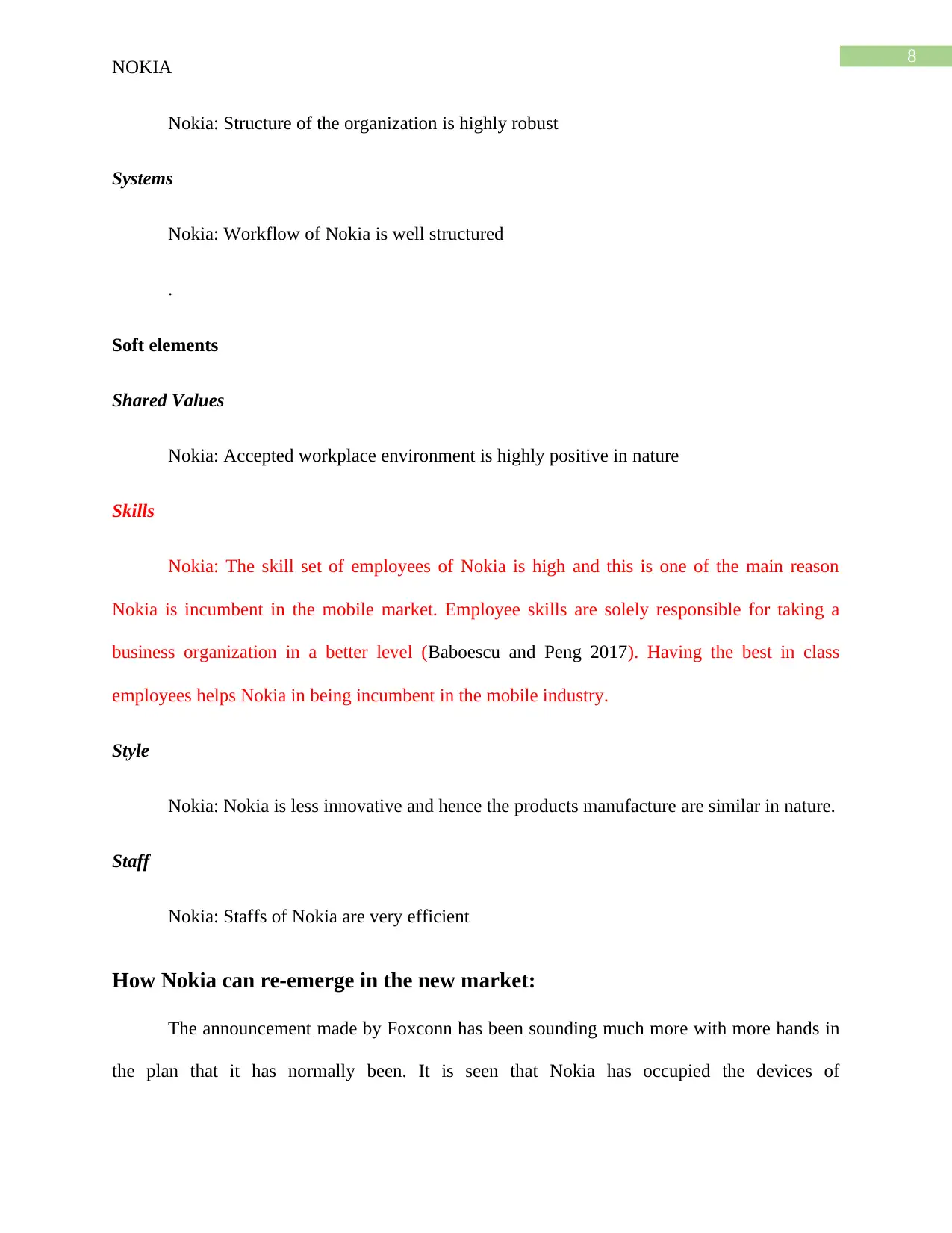
8
NOKIA
Nokia: Structure of the organization is highly robust
Systems
Nokia: Workflow of Nokia is well structured
.
Soft elements
Shared Values
Nokia: Accepted workplace environment is highly positive in nature
Skills
Nokia: The skill set of employees of Nokia is high and this is one of the main reason
Nokia is incumbent in the mobile market. Employee skills are solely responsible for taking a
business organization in a better level (Baboescu and Peng 2017). Having the best in class
employees helps Nokia in being incumbent in the mobile industry.
Style
Nokia: Nokia is less innovative and hence the products manufacture are similar in nature.
Staff
Nokia: Staffs of Nokia are very efficient
How Nokia can re-emerge in the new market:
The announcement made by Foxconn has been sounding much more with more hands in
the plan that it has normally been. It is seen that Nokia has occupied the devices of
NOKIA
Nokia: Structure of the organization is highly robust
Systems
Nokia: Workflow of Nokia is well structured
.
Soft elements
Shared Values
Nokia: Accepted workplace environment is highly positive in nature
Skills
Nokia: The skill set of employees of Nokia is high and this is one of the main reason
Nokia is incumbent in the mobile market. Employee skills are solely responsible for taking a
business organization in a better level (Baboescu and Peng 2017). Having the best in class
employees helps Nokia in being incumbent in the mobile industry.
Style
Nokia: Nokia is less innovative and hence the products manufacture are similar in nature.
Staff
Nokia: Staffs of Nokia are very efficient
How Nokia can re-emerge in the new market:
The announcement made by Foxconn has been sounding much more with more hands in
the plan that it has normally been. It is seen that Nokia has occupied the devices of
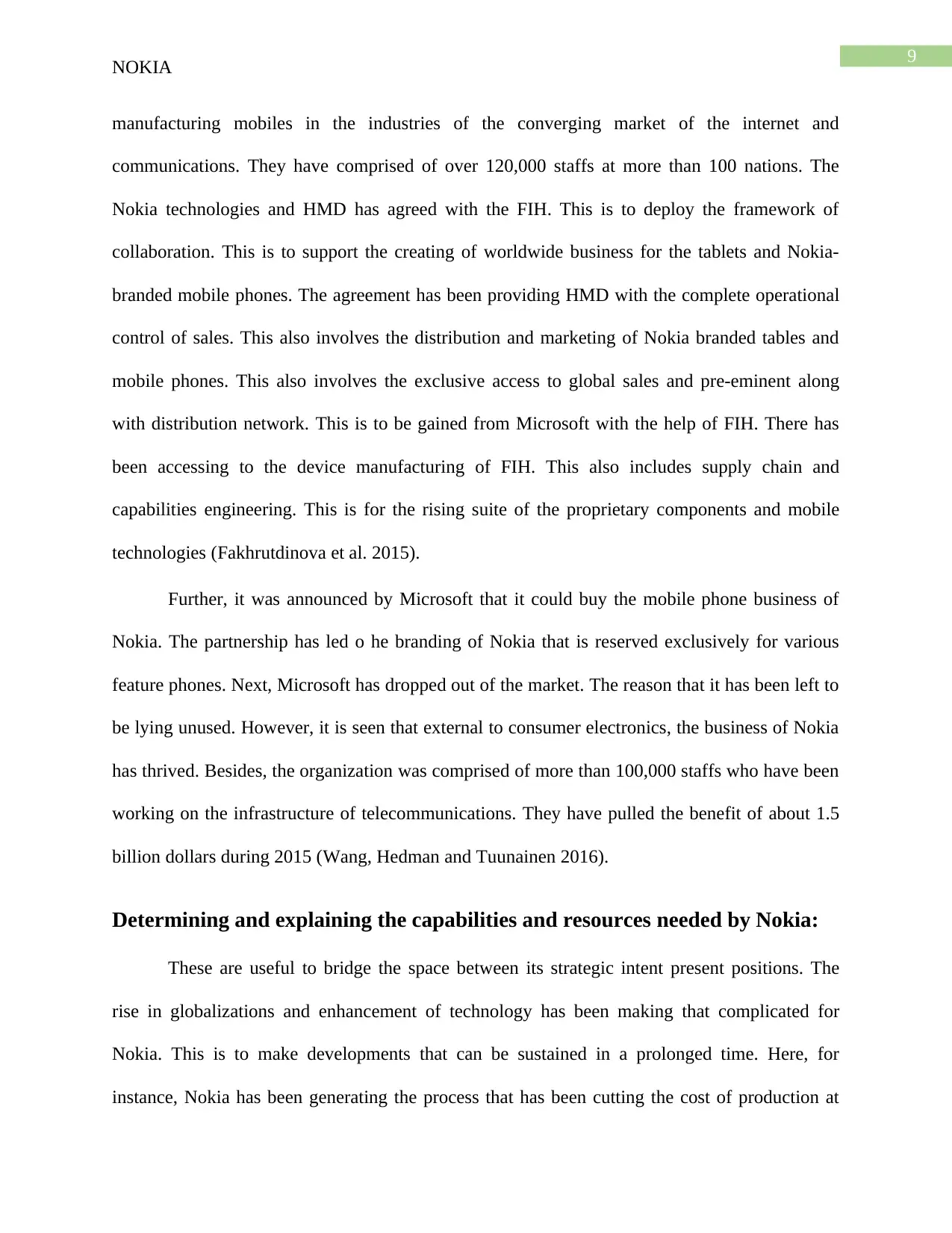
9
NOKIA
manufacturing mobiles in the industries of the converging market of the internet and
communications. They have comprised of over 120,000 staffs at more than 100 nations. The
Nokia technologies and HMD has agreed with the FIH. This is to deploy the framework of
collaboration. This is to support the creating of worldwide business for the tablets and Nokia-
branded mobile phones. The agreement has been providing HMD with the complete operational
control of sales. This also involves the distribution and marketing of Nokia branded tables and
mobile phones. This also involves the exclusive access to global sales and pre-eminent along
with distribution network. This is to be gained from Microsoft with the help of FIH. There has
been accessing to the device manufacturing of FIH. This also includes supply chain and
capabilities engineering. This is for the rising suite of the proprietary components and mobile
technologies (Fakhrutdinova et al. 2015).
Further, it was announced by Microsoft that it could buy the mobile phone business of
Nokia. The partnership has led o he branding of Nokia that is reserved exclusively for various
feature phones. Next, Microsoft has dropped out of the market. The reason that it has been left to
be lying unused. However, it is seen that external to consumer electronics, the business of Nokia
has thrived. Besides, the organization was comprised of more than 100,000 staffs who have been
working on the infrastructure of telecommunications. They have pulled the benefit of about 1.5
billion dollars during 2015 (Wang, Hedman and Tuunainen 2016).
Determining and explaining the capabilities and resources needed by Nokia:
These are useful to bridge the space between its strategic intent present positions. The
rise in globalizations and enhancement of technology has been making that complicated for
Nokia. This is to make developments that can be sustained in a prolonged time. Here, for
instance, Nokia has been generating the process that has been cutting the cost of production at
NOKIA
manufacturing mobiles in the industries of the converging market of the internet and
communications. They have comprised of over 120,000 staffs at more than 100 nations. The
Nokia technologies and HMD has agreed with the FIH. This is to deploy the framework of
collaboration. This is to support the creating of worldwide business for the tablets and Nokia-
branded mobile phones. The agreement has been providing HMD with the complete operational
control of sales. This also involves the distribution and marketing of Nokia branded tables and
mobile phones. This also involves the exclusive access to global sales and pre-eminent along
with distribution network. This is to be gained from Microsoft with the help of FIH. There has
been accessing to the device manufacturing of FIH. This also includes supply chain and
capabilities engineering. This is for the rising suite of the proprietary components and mobile
technologies (Fakhrutdinova et al. 2015).
Further, it was announced by Microsoft that it could buy the mobile phone business of
Nokia. The partnership has led o he branding of Nokia that is reserved exclusively for various
feature phones. Next, Microsoft has dropped out of the market. The reason that it has been left to
be lying unused. However, it is seen that external to consumer electronics, the business of Nokia
has thrived. Besides, the organization was comprised of more than 100,000 staffs who have been
working on the infrastructure of telecommunications. They have pulled the benefit of about 1.5
billion dollars during 2015 (Wang, Hedman and Tuunainen 2016).
Determining and explaining the capabilities and resources needed by Nokia:
These are useful to bridge the space between its strategic intent present positions. The
rise in globalizations and enhancement of technology has been making that complicated for
Nokia. This is to make developments that can be sustained in a prolonged time. Here, for
instance, Nokia has been generating the process that has been cutting the cost of production at
Secure Best Marks with AI Grader
Need help grading? Try our AI Grader for instant feedback on your assignments.
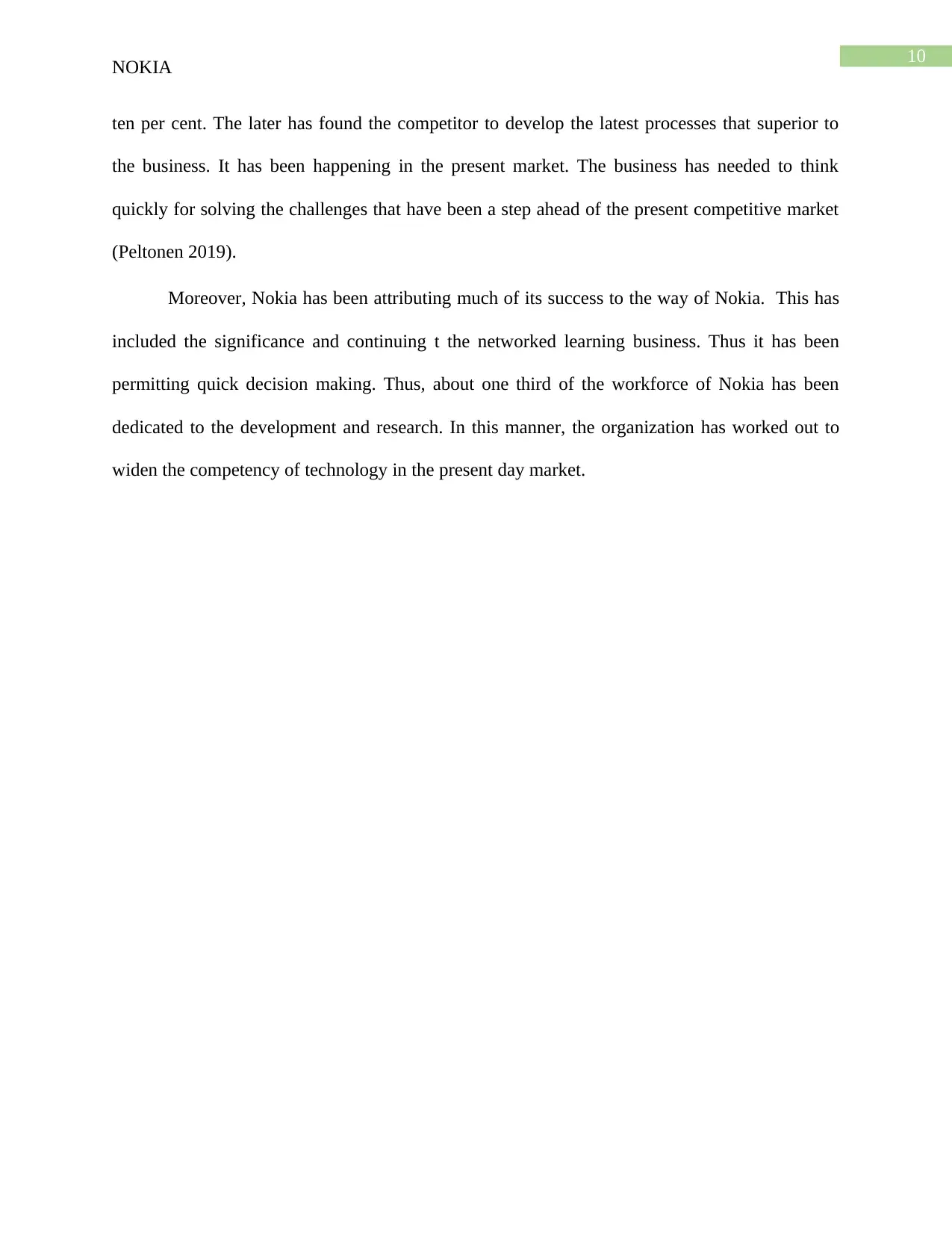
10
NOKIA
ten per cent. The later has found the competitor to develop the latest processes that superior to
the business. It has been happening in the present market. The business has needed to think
quickly for solving the challenges that have been a step ahead of the present competitive market
(Peltonen 2019).
Moreover, Nokia has been attributing much of its success to the way of Nokia. This has
included the significance and continuing t the networked learning business. Thus it has been
permitting quick decision making. Thus, about one third of the workforce of Nokia has been
dedicated to the development and research. In this manner, the organization has worked out to
widen the competency of technology in the present day market.
NOKIA
ten per cent. The later has found the competitor to develop the latest processes that superior to
the business. It has been happening in the present market. The business has needed to think
quickly for solving the challenges that have been a step ahead of the present competitive market
(Peltonen 2019).
Moreover, Nokia has been attributing much of its success to the way of Nokia. This has
included the significance and continuing t the networked learning business. Thus it has been
permitting quick decision making. Thus, about one third of the workforce of Nokia has been
dedicated to the development and research. In this manner, the organization has worked out to
widen the competency of technology in the present day market.

11
NOKIA
References
Alamsyah, A., Rahmah, W. and Irawan, H., 2015. Sentiment Analysis Based on Appraisal
Theory for Marketing Intelligence in Indonesia's Mobile Phone Market. Journal of Theoretical
and Applied Information Technology, 82(2), p.335.
Baboescu, F. and Peng, S., 2017. INTAREA S. Kanugovi Internet-Draft S. Vasudevan Intended
status: Standards Track Nokia Expires: September 14, 2017 J. Zhu Intel.
Chaplinsky, S., Marston, F.C., Chaplinsky, S. and Marston, F.C., 2017. Nokia OYJ: Financing
the WP Strategic Plan. Darden Business Publishing Cases, pp.1-25.
Fakhrutdinova, E.V., Fakhrutdinov, R.M., Kolesnikova, J.S. and Yurieva, O., 2015. New Start of
Nokia. Mediterranean Journal of Social Sciences, 6(1 S3), p.61.
Jia, J. and Yin, Y., 2015. Analysis of Nokia’s decline from marketing perspective. Open Journal
of Business and Management, 3(04), p.446.
Majanoja, A.M., Linko, L. and Leppänen, V., 2017. Global corrective action preventive action
process and solution: insights at the Nokia Devices operation unit. International Journal of
Productivity and Quality Management, 20(1), pp.29-47.
McWilliams, T., Reimer, B., Mehler, B., Dobres, J. and Coughlin, J.F., 2015, September. Effects
of age and smartphone experience on driver behavior during address entry: A comparison
between a Samsung Galaxy and Apple iPhone. In Proceedings of the 7th International
Conference on Automotive User Interfaces and Interactive Vehicular Applications (pp. 150-153).
ACM.
NOKIA
References
Alamsyah, A., Rahmah, W. and Irawan, H., 2015. Sentiment Analysis Based on Appraisal
Theory for Marketing Intelligence in Indonesia's Mobile Phone Market. Journal of Theoretical
and Applied Information Technology, 82(2), p.335.
Baboescu, F. and Peng, S., 2017. INTAREA S. Kanugovi Internet-Draft S. Vasudevan Intended
status: Standards Track Nokia Expires: September 14, 2017 J. Zhu Intel.
Chaplinsky, S., Marston, F.C., Chaplinsky, S. and Marston, F.C., 2017. Nokia OYJ: Financing
the WP Strategic Plan. Darden Business Publishing Cases, pp.1-25.
Fakhrutdinova, E.V., Fakhrutdinov, R.M., Kolesnikova, J.S. and Yurieva, O., 2015. New Start of
Nokia. Mediterranean Journal of Social Sciences, 6(1 S3), p.61.
Jia, J. and Yin, Y., 2015. Analysis of Nokia’s decline from marketing perspective. Open Journal
of Business and Management, 3(04), p.446.
Majanoja, A.M., Linko, L. and Leppänen, V., 2017. Global corrective action preventive action
process and solution: insights at the Nokia Devices operation unit. International Journal of
Productivity and Quality Management, 20(1), pp.29-47.
McWilliams, T., Reimer, B., Mehler, B., Dobres, J. and Coughlin, J.F., 2015, September. Effects
of age and smartphone experience on driver behavior during address entry: A comparison
between a Samsung Galaxy and Apple iPhone. In Proceedings of the 7th International
Conference on Automotive User Interfaces and Interactive Vehicular Applications (pp. 150-153).
ACM.
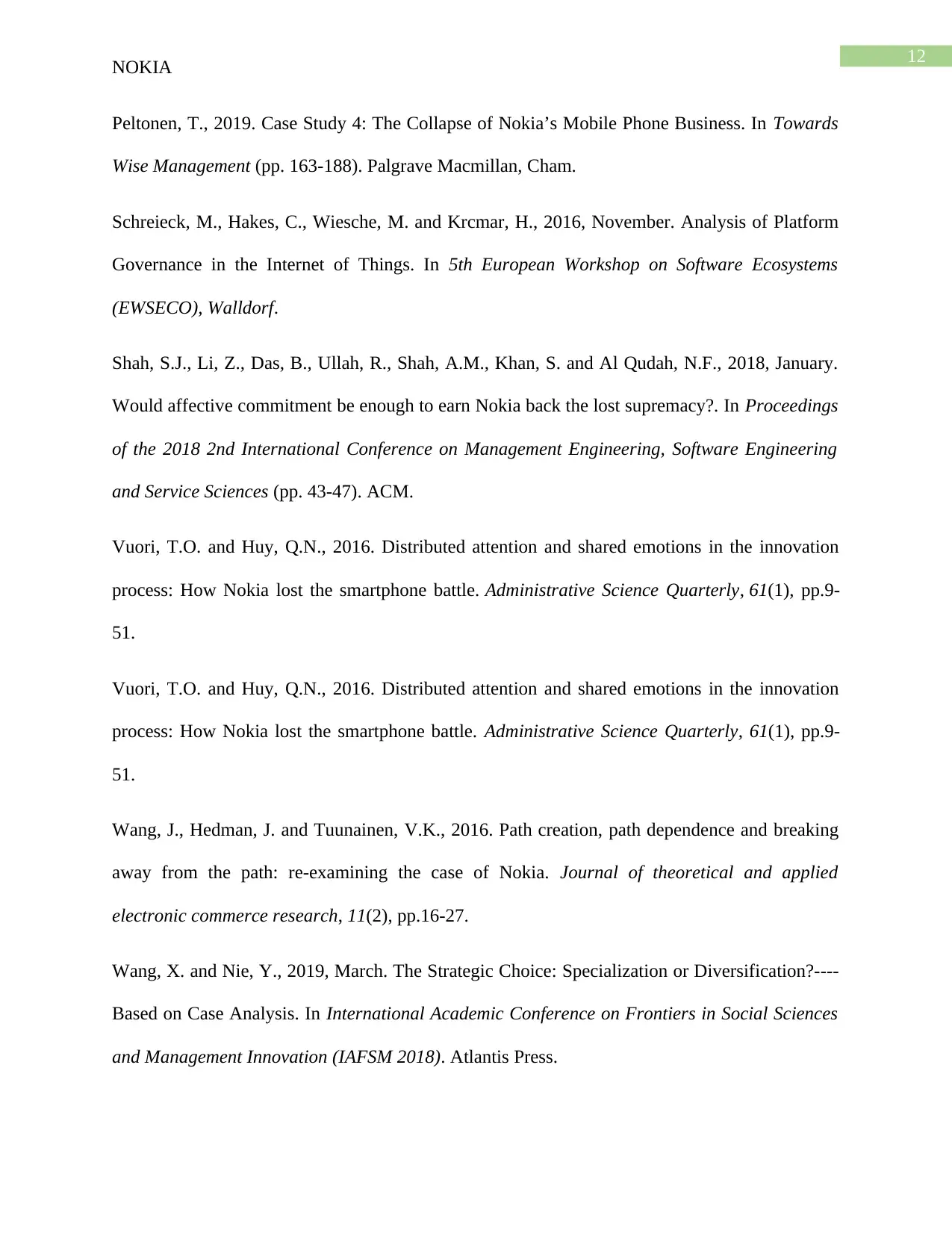
12
NOKIA
Peltonen, T., 2019. Case Study 4: The Collapse of Nokia’s Mobile Phone Business. In Towards
Wise Management (pp. 163-188). Palgrave Macmillan, Cham.
Schreieck, M., Hakes, C., Wiesche, M. and Krcmar, H., 2016, November. Analysis of Platform
Governance in the Internet of Things. In 5th European Workshop on Software Ecosystems
(EWSECO), Walldorf.
Shah, S.J., Li, Z., Das, B., Ullah, R., Shah, A.M., Khan, S. and Al Qudah, N.F., 2018, January.
Would affective commitment be enough to earn Nokia back the lost supremacy?. In Proceedings
of the 2018 2nd International Conference on Management Engineering, Software Engineering
and Service Sciences (pp. 43-47). ACM.
Vuori, T.O. and Huy, Q.N., 2016. Distributed attention and shared emotions in the innovation
process: How Nokia lost the smartphone battle. Administrative Science Quarterly, 61(1), pp.9-
51.
Vuori, T.O. and Huy, Q.N., 2016. Distributed attention and shared emotions in the innovation
process: How Nokia lost the smartphone battle. Administrative Science Quarterly, 61(1), pp.9-
51.
Wang, J., Hedman, J. and Tuunainen, V.K., 2016. Path creation, path dependence and breaking
away from the path: re-examining the case of Nokia. Journal of theoretical and applied
electronic commerce research, 11(2), pp.16-27.
Wang, X. and Nie, Y., 2019, March. The Strategic Choice: Specialization or Diversification?----
Based on Case Analysis. In International Academic Conference on Frontiers in Social Sciences
and Management Innovation (IAFSM 2018). Atlantis Press.
NOKIA
Peltonen, T., 2019. Case Study 4: The Collapse of Nokia’s Mobile Phone Business. In Towards
Wise Management (pp. 163-188). Palgrave Macmillan, Cham.
Schreieck, M., Hakes, C., Wiesche, M. and Krcmar, H., 2016, November. Analysis of Platform
Governance in the Internet of Things. In 5th European Workshop on Software Ecosystems
(EWSECO), Walldorf.
Shah, S.J., Li, Z., Das, B., Ullah, R., Shah, A.M., Khan, S. and Al Qudah, N.F., 2018, January.
Would affective commitment be enough to earn Nokia back the lost supremacy?. In Proceedings
of the 2018 2nd International Conference on Management Engineering, Software Engineering
and Service Sciences (pp. 43-47). ACM.
Vuori, T.O. and Huy, Q.N., 2016. Distributed attention and shared emotions in the innovation
process: How Nokia lost the smartphone battle. Administrative Science Quarterly, 61(1), pp.9-
51.
Vuori, T.O. and Huy, Q.N., 2016. Distributed attention and shared emotions in the innovation
process: How Nokia lost the smartphone battle. Administrative Science Quarterly, 61(1), pp.9-
51.
Wang, J., Hedman, J. and Tuunainen, V.K., 2016. Path creation, path dependence and breaking
away from the path: re-examining the case of Nokia. Journal of theoretical and applied
electronic commerce research, 11(2), pp.16-27.
Wang, X. and Nie, Y., 2019, March. The Strategic Choice: Specialization or Diversification?----
Based on Case Analysis. In International Academic Conference on Frontiers in Social Sciences
and Management Innovation (IAFSM 2018). Atlantis Press.
Paraphrase This Document
Need a fresh take? Get an instant paraphrase of this document with our AI Paraphraser

13
NOKIA
NOKIA
1 out of 14
Related Documents
Your All-in-One AI-Powered Toolkit for Academic Success.
+13062052269
info@desklib.com
Available 24*7 on WhatsApp / Email
![[object Object]](/_next/static/media/star-bottom.7253800d.svg)
Unlock your academic potential
© 2024 | Zucol Services PVT LTD | All rights reserved.




